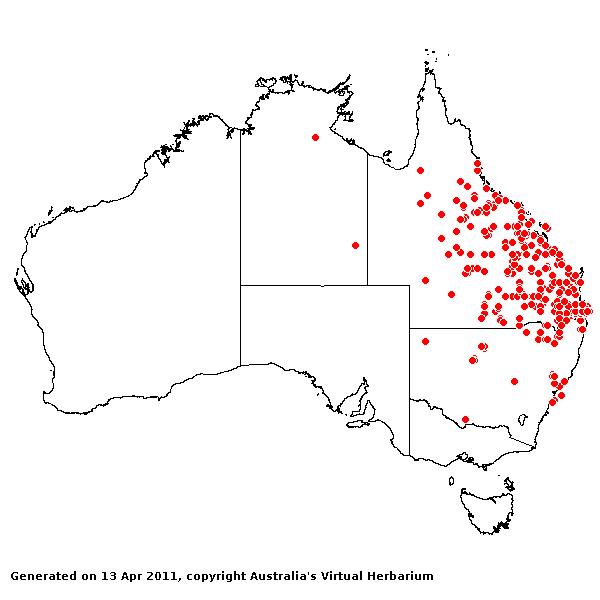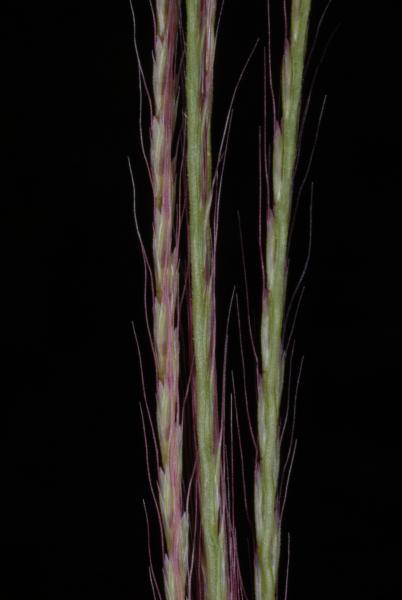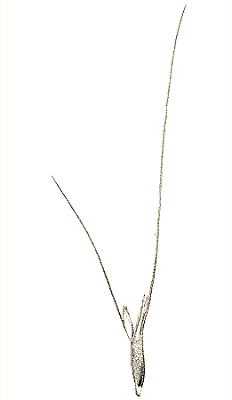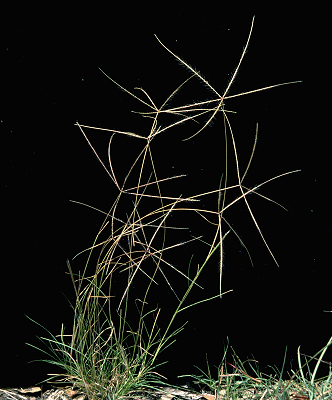Chloris divaricata R. Br. Prodr.
186 (1810).
Classification. (GPWG 2001) : Subfamily Chloridoideae. Cynodonteae.
Type of Basionym or
Protologue Information: ST: Brown 6244, Sep 1802, Australia: Queensland: Port Curtis Dist: Broad Sound
(BM; IST: E, K, MEL).
LT: R. Brown, Australia: "Port I., Keppel
Bay, Whorlwater Bay"
(BM). LT designated by Anderson, Brigham Young Univ. Sci. Bull., Biol. Ser.,
19(2): 85 (1974).
Key references
(books and floras): [1810]. R.Brown, Prodromus (186), [1878]
G.Bentham, Flora Australiensis 7 (612), [2002] D.Sharp & B.K.Simon, AusGrass,
Grasses of Australia, [2008] S.W.L.Jacobs, R.D.B.Walley &
D.J.B.Wheeler, Grasses of New South Wales (183).
Illustrations:
[1983] J.C.Tothill & J.B.Hacker, Grasses of Southern Queensland
(156(3)), [2005] K.Mallet (ed.), Flora of Australia 44B: Poaceae 3
(Fig. 41B& Fig. 43C as var. divaricata), [2008] S.W.L.Jacobs,
R.D.B.Whalley & D.J.B.Wheeler, Grasses of New South Wales, 4th edn
(183).
Habit.
Perennial. Stolons absent or present. Culms erect or decumbent, 25–60 cm tall.
Leaf-sheaths glabrous on surface. Ligule a fringed membrane, a ciliolate
membrane or a ciliate membrane, 0.4–0.6 mm long. Leaf-blades 3–15 cm long, 1–2
mm wide. Leaf-blade surface smooth or scaberulous.
Inflorescence.
Inflorescence digitate, with spicate branches.
Spikelets.
Spikelets sessile or pedicelled. Fertile spikelets 1 or more flowered, with 1
fertile floret, comprising 1–2 fertile floret(s), with diminished florets at
the apex, cuneate, laterally compressed, 2.9–4 mm long.
Glumes. Glumes
similar, thinner than fertile lemma. Lower glume lanceolate, membranous,
keeled, 1-keeled, 1 -nerved. Upper glume lanceolate, 2–3 mm long, membranous,
keeled, 1-keeled, 1 -nerved. Upper glume surface smooth or asperulous or
scabrous.
Florets.
Fertile lemma 2–4 mm long, keeled, 3 -nerved. Lemma apex dentate or lobed,
awned, 1 -awned. Median (principal) awn from a sinus, 3–17 mm long overall.
Lodicules present. Anthers 3. Grain 1.5–2.2 mm long.
Continental
Distribution: Australasia and Pacific.
Australian
Distribution: Northern Territory, Queensland, New
South Wales.
Northern Territory: Darwin &
Gulf. Queensland: Burke, Burnett, Cook,
Darling Downs, Leichhardt, Maranoa, Mitchell, Moreton, North Kennedy, Port
Curtis, South Kennedy, Warrego, Wide
Bay, Gregory South. New South Wales: North
Coast, Central Coast,
North-Western Slopes, Central-Western Slopes, North-Western Plains.
Notes.
Native to New Caledonia, New Hebrides, Fiji Islands, Hawaiian Islands,
Australia. Australian distribution in coastal and central-western areas of Qld
and N.S.W., extending from N of Cairns to S of Sydney. Occurs on a variety of
soils, often in disturbed habitats. There are two varieties.
Infra-specific
taxa: var. divaricata, var. cynodontoides .
Spikelet-bearing axes
3–6, rigid C. divaricata var. cynodontoides
Spikelet bearing axes 5–8, flaccid C. divaricata var. divaricata








